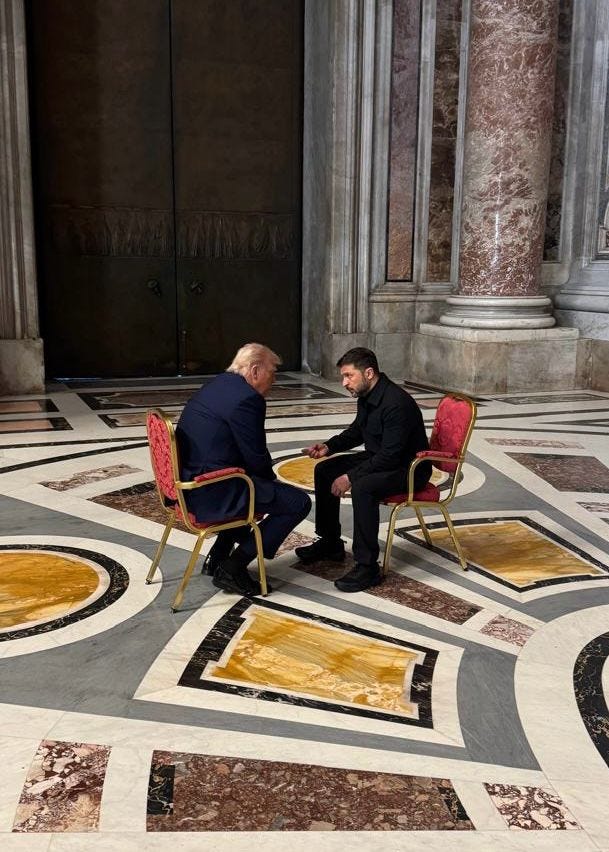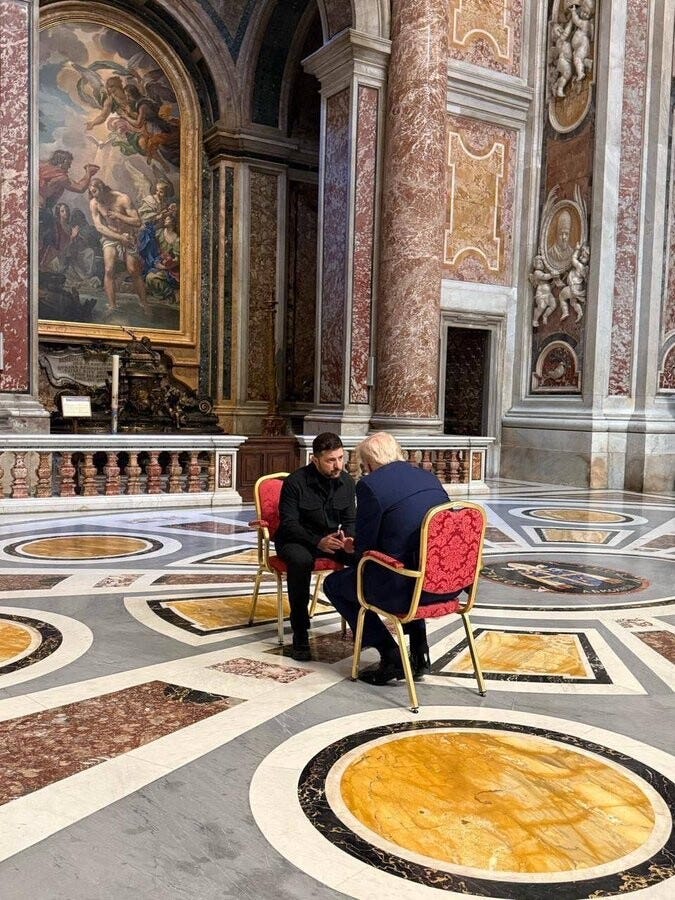A peace plan nobody likes
A hundred days into his presidency, Trump is yet to deliver even a short-term ceasefire.
Hello and welcome to your weekly briefing on Ukraine.
Before we begin…I was in Washington this week for the very last event dedicated to our Escalation podcast, and someone in the audience asked what is the best thing an American can do to help Ukraine in these fraught times. I am asked this regularly, and my answer is always the same — give money to the Ukrainian army. It’s the single most effective thing you can do. If you were looking for ways to help too, click on the link below and subscribe for regular donations.
Kyiv under attack. This week, Ukraine’s capital Kyiv suffered one of the deadliest Russian attacks in years. On Wednesday night, Russia attacked the capital with dozens of missiles and drones, damaging many apartment buildings, a school, and a kindergarten. Twelve people were killed and more than 80, including six children and a pregnant woman, were injured. Among the killed was a 17-year-old boy whose teenage friends waited all day near the site, hoping the rescuers would find him alive.
The scale of the destruction was shocking because attacks on Kyiv, as scary as they are in the moment, almost never have casualties. I’ve lived in Kyiv for the past two years, pregnant and then with a baby, and I’ve always felt safe enough to stay because the capital’s air defence is the best in the country.
The attack even made Donald Trump unhappy, who wrote online a rare critique of the Kremlin: “Not necessary, and very bad timing. Vladimir, STOP!”
Two one-pagers. Three months into Trump’s presidency, the world finally got a glimpse of his plan to end the war in Ukraine. The American peace deal is reportedly a one-page document, which was first presented to European and Ukrainian officials last week in Paris. Ukraine and Europe responded with a counterproposal this week. According to Reuters, who published the text of both proposals, each document has a list of points in four categories: ceasefire, security guarantees, territory, and economics. Here are the key details:
Ceasefire — both documents include a full ceasefire, but Ukraine’s counterproposal also includes Russia unconditionally returning all kidnapped Ukrainian children and civillian prisoners, as well as an “all for all” exchange of prisoners of war.
Security guarantees — American version says Ukraine receives “a robust security guarantee” from an “ad hoc grouping of European states plus willing non-European states”, and that Ukraine “will not seek to join NATO”. The counterproposal says that apart from the European security guarantees, Ukraine also makes an Article-5-like agreement with the US. The latter also spells out that there won’t be any restrictions on the size of Ukraine’s military and the presence of foreign troops and weapons in Ukraine.
Territory — the US wants to provide “de jure recognition of Russian control of Crimea”, as well as “de facto recognition" of Russian occupation of parts of Luhansk, Zaporizhzhia, Donetsk, and Kherson oblasts. The counterproposal instead says that all territorial issues will be resolved only after a ceasefire. Both proposals say Ukraine will enjoy “unhindered passage on Dnieper River”, parts of which run near the front line. Both sides also say that Ukraine will regain control of the now-occupied Zaporizhzhia Nuclear Power Plant “through US control and administration of the plant”. The US version stipulates that the plant will distribute electricity to “both sides”, meaning that a Ukrainian US-run NPP will supply Russian-occupied territories.
Economics — the US version says all sanctions on Russia will be lifted, and the US and Russia will engage in economic cooperation. The counterproposal says that gradual sanctions relief will be dependent on achieving sustainable peace, and sanctions will resume if Russia breaches the agreement. Both proposals say “Ukraine will be fully reconstructed and compensated financially”, while Ukraine’s counterproposal adds that the compensation will come “through Russian sovereign assets that will remain frozen until Russia compensates damage to Ukraine”.
The American proposal, which Ukraine and Russia are yet to embrace, doesn’t ask Ukraine to cede more territory, nor does it regulate the size of Ukraine’s armed forces. So in short, I agree with The Economist’s assessement: “The best that can be said for the American plan is that it fails to give Mr Putin everything he wants.”
Crimea debacle. The most shocking part of Trump’s deal is its de-jure recognition Russian occupation of Crimea. Such a move would overturn one of the most sacred principles of international order, which affirms that one state can’t forcibly change the borders of another. It would essentially tell dictators around the world, including China, that seizing territory is a-okay, and that international law is irrelevant.
Ironically, Trump’s Secretary of State Rubio actively opposed recognizing Russian occupation during his time in the Senate. In 2022, Rubio even co-sponsored a measure that prohibits the US from recognizing “any Russian claim of sovereignty” of Ukrainian land. During Trump’s first term, Secretary of State Mike Pompeo passed what’s called a “Crimea Declaration”, which similarly pledged to oppose Russian threats to Ukraine’s territorial integrity.
Ukraine’s reaction was unequivocal: “Ukraine will not legally recognize the occupation of Crimea,” Zelensky said at a news conference. “There’s nothing to talk about here. This is against our Constitution.”
Trump’s response was ugly, as always: “Nobody is asking Zelenskyy to recognize Crimea as Russian Territory,” Trump wrote on Truth Social. ”If he wants Crimea, why didn’t they fight for it eleven years ago when it was handed over to Russia without a shot being fired?” Trump added. If you are curious about that too, check out Episode 5 of Escalation podcast. (Spoiler: the Americans told us not to fight.)
Sidelines of a funeral. With tensions running high, Trump and Zelensky had an extraordinary meeting during the funeral of Pope Francis on Saturday. Just look at the photos:


That’s right. A one-on-one conversation without aides (without anything or anyone, really) at the Vatican’s St. Peter’s Basilica. It was their first meeting since the Oval Office disaster nearly two months ago, and Kyiv said it lasted around 15 minutes. If this wasn’t shocking enough, here’s what Trump posted on Trush Social right after:
“…there was no reason for Putin to be shooting missiles into civilian areas, cities and towns, over the last few days. It makes me think that maybe he doesn’t want to stop the war, he’s just tapping me along, and has to be dealt with differently, through “Banking” or “Secondary Sanctions?”.
Hooray! Forty-seven days after Russia rejected a ceasefire, Trump is finally catching up to the fact that Russia “doesn’t want to stop the war”. In the words of iconic Ukrainian writer Lesya Ukrainka: I would laugh to keep from crying.
Other stories I’m following…
From European Pravda: Trump’s Crimea trap: why the US wants Ukraine’s "consent" to call the peninsula Russian Trump said no one was asking Ukraine to recognize Crimea as Russia. But Kyiv would have to sign a peace deal that mentioned America’s recognition, which could set off an array of legal problems for Ukraine.
From Lawfare’s Scott R. Anderson: The White House Can’t Accept Russia’s Annexation of Crimea Without Congress Check out my colleague’s legal analysis of the Crimea question from an American point of view.
From The Economist: Why Ukraine is losing the war for African opinion Zelensky made his first trip to South Africa this week. I thought the timing was strange, given the stakes of America-led peace negotiations. The Economist argues the whole trip may have been useless.
I’ll be back next week.
Cheers,
— Yours Ukrainian





I found this deeply disturbing in one of the links you provided: "Since its landmark 2015 decision in the matter of Zivotofsky v. Kerry, the Supreme Court has held that “the power to recognize or decline to recognize a foreign state and its territorial bounds resides in the President alone” and thus beyond congressional interference." Really?! Another one of the SCOTUS inexplicably ridiculous decisions. OMG
Russia has no reason to stop and every reason to keep going.